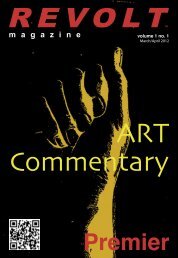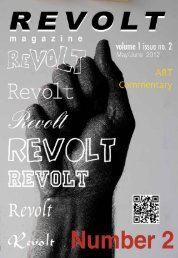Download PDF Version Revolt Magazine, Volume 1 Issue No.4
Download PDF Version Revolt Magazine, Volume 1 Issue No.4
Download PDF Version Revolt Magazine, Volume 1 Issue No.4
Create successful ePaper yourself
Turn your PDF publications into a flip-book with our unique Google optimized e-Paper software.
Westbeth Artists' Housing, New York, A205 North Elevation. Arctitectural drawing courtesy of Eileen Marie Lynch Interiors.<br />
WESTBETH<br />
ARTISTS HOUSING<br />
COMMUNITY<br />
BY LENA VAZIFDAR<br />
Westbeth Home to the Arts<br />
Nearly every corner and hallway of Jon D’Orazio’s<br />
studio is stacked with paintings. A series of largescale<br />
iridescent circles on canvas in bright, almost<br />
neon, color schemes are laid on top of each other<br />
in rows and his walls are adorned with abstract<br />
works he painted himself. The space, enclosed<br />
in canvases, gives way to just enough room for a<br />
couch and a coffee table. Jon has lived within the<br />
walls of Manhattan’s Westbeth Home to the Arts<br />
since its opening in 1970.<br />
When it opened its doors nearly 43 years ago<br />
as affordable housing for artists, the area of<br />
Manhattan’s West Village on Bethune and<br />
Washington streets was desolate. Now, posh<br />
mothers and fathers with strollers take long<br />
walks through its tree-lined boulevards. Designer<br />
boutiques and coffee shops selling $5 lattes, pop<br />
up one after the other next to quaint wine bars.<br />
It’s easily one of the most coveted and expensive<br />
areas of Manhattan to reside and Jon has been<br />
there observing its transformation; watching it<br />
go from one phase to the next slowly gentrifying<br />
on every street corner over decades. When Jon<br />
moved in, as a fresh-faced twenty something,<br />
the Westside highway’s piers, which now boast<br />
manicured lawns and bike trails, were just pier<br />
after pier with miles of corrugated metal.<br />
REVOLT<br />
<strong>Magazine</strong> Number 4, 2013<br />
“It was basically still a dead zone,” said Jon. “The<br />
meat market was active just north of here and it<br />
was scary. You didn’t want to walk around at night.<br />
Washington street, which is really active now,<br />
didn’t have any streetlights, and at night it was just<br />
darkness.”<br />
The meat market Jon speaks of is now the Meat<br />
Packing District, a glitzy area for stiletto wearing<br />
Manhattanites ready for champagne sipping at The<br />
Standard Hotel or The Gansevoort and shopping at<br />
Alexander McQueen and Diane Von Furstenberg.<br />
The Highline, Manhattan’s architectural gem and<br />
over ground park now intersects the area which<br />
was once just meat factories and barren concrete.<br />
There’s hardly a remnant of what it once was.<br />
Westbeth’s building takes up the entire city block.<br />
It used to be home to Bell Laboratories before<br />
it was purchased to become affordable housing<br />
for artists. Bell laboratories was the historic site<br />
where the first talking movie and TV broadcast<br />
was produced. With funding spearheaded by Joan<br />
Davidson of the J.M. Kaplan Foundation and Roger<br />
Stevens of the National Endowment of the Arts,<br />
Westbeth was born.<br />
Richard Meier was commissioned to renovate the<br />
former Bell Laboratories in 1967, before he was<br />
the Richard Meier that many know as the architect<br />
behind large scale modern beauties like the Getty<br />
Center in Los Angeles and the Barcelona Museum<br />
of Contemporary Art. He went on to win the Pritzker<br />
Prize in 1984, which is one of the highest honors<br />
in the field. Meier said in an interview with the<br />
Greenwich Village Society for Historic Preservation<br />
that the idea of the live/work space was highly<br />
unsual at the time of Westbeth’s creation. New<br />
York City building code did not permit working<br />
and living in the same space and so they had to<br />
change the zoning in order to create something<br />
that never existed before. The building code also<br />
had to be changed to allow for working and living in<br />
the same space.<br />
Architect Richard Kaplan was a friend of Meier’s<br />
and asked him to go with him to meet his father,<br />
Jack Kaplan, as well as Roger Stevens, who was<br />
head of the National Endowment of the Arts.<br />
They walked through the buildings of the Bell<br />
laboratories together to talk about ideas for the<br />
site. Meier quickly became the man behind the<br />
creation and it now stands as a testament to<br />
his early work as well as a historic monument in<br />
New York City. Westbeth was recently put under<br />
consideration to become a landmark under NYC<br />
Landmark laws and it has already been nominated<br />
to the State Registrar of Historic Places and to the<br />
National Registrar of historic Places.<br />
Joan Davidson was also a major player in the<br />
creation of Westbeth. Her father Jack Kaplan<br />
turned the project over to her and it was<br />
20





